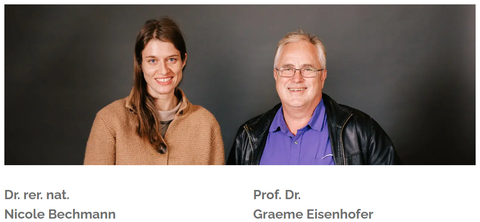Project B12
HIF-MYC/MAX pathway in neural-crest derived catecholamine producing tumours: Identification of a metabolic fingerprint related to tumour aggressiveness
Neural-crest derived catecholamine-producing (NCCP) tumours such as neuroblastomas, phaeochromocytomas and paragangliomas (PPGL) are characterised by variable tumour aggressiveness; the mechanisms underlying this variability remain largely unclear. We demonstrated that HIF2α plays a fundamental role in determining the phenotypic fate of PPGLs, including potential for metastatic behaviour. HIF2α also appears to be involved in determining phenotypic maturity and aggressiveness of neuroblastoma, suggesting some commonalities among NCCP tumours. These findings provide the basis for our underlying hypothesis that HIF2α-related pathways involving the MYC/MAX complex are directly linked with differentiation and aggressiveness of NCCP tumours. Therefore, our primary objective is to identify the mechanisms by which HIF2α and HIF1α differentially affect the MYC/MAX complex leading to variable NCCP tumour aggressiveness. In related work, we also aim to exploit our available data and patient specimens to develop diagnostic and prognostic tools for metastatic behaviour. Our existing in vitro models and tumour materials will be used to identify distinct metabolic fingerprints in different subtypes of NCCP tumours. These data will then be employed for disease stratification and for potential targeted therapeutic interventions. To translate our results into clinical application, we will correlate our in vitro findings with patient data by utilising our banks of tumour specimens and liquid biopsies and associated clinical data. As a starting point, our metabolomics and proteomics data in PPGLs will be correlated to underlying gene mutations, catecholamine phenotypes and metastatic disease status. We expect that the proposed project will contribute to improved identification of aggressive NCCP tumours. Elucidation of the underlying cellular and molecular mechanisms of disease aggressiveness might also lead to novel targeted approaches for treating patients with NCCP tumours according to metabolic profiles.
Aims
(I) Establish functional links between hypoxia pathways, tumour differentiation and aggressiveness in different NCCP tumours.
(II) Investigate the mechanisms involving the MYC/MAX complex, by which HIF2α and HIF1α differentially affect NCCP tumour aggressiveness.
(III) Identify and establish clinical predictors and metabolic fingerprints related to NCCP tumour aggressiveness as diagnostic and prognostic tools for the prediction of disease progression and malignancy.
| Principal Investigators | Institution |
| Prof. Dr. Graeme Eisenhofer | TUD |
| Dr. rer. nat. Nicole Bechmann | TUD |

